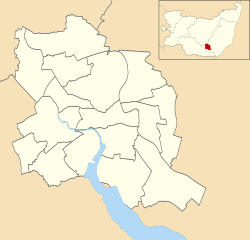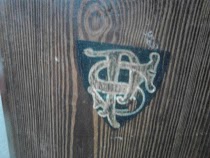St Pancras Church, Ipswich facts for kids
Quick facts for kids St Pancras, Ipswich |
|
|---|---|
| Saint Pancras | |
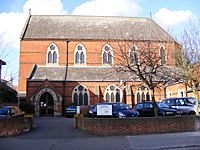
Saint Pancras Church
|
|
| 52°03′20.7″N 1°09′31.8″E / 52.055750°N 1.158833°E | |
| Location | Ipswich, Suffolk |
| Country | England |
| Denomination | Roman Catholic |
| Weekly attendance | 500 |
| History | |
| Status | Active |
| Founded | 1861 |
| Dedication | Saint Pancras of Rome |
| Architecture | |
| Heritage designation | Grade II |
| Designated | 6 April 1988 |
| Architect(s) | George Goldie |
| Architectural type | Victorian Gothic |
| Administration | |
| Deanery | Ipswich Deanery |
| Diocese | Roman Catholic Diocese of East Anglia |
Saint Pancras is a Roman Catholic church in Ipswich, England. It is a busy church in the town center. This church was built a long time ago, in the 1800s. It has a special style called neo-Gothic. When it was first finished, there were some protests against it.
How St Pancras Church Was Built
Most of the money to build St Pancras came from a man named L'Abbé Louis Simon. He was a French priest who came to Ipswich in 1793. This was during the French Revolution. He was the first Catholic priest to hold regular church services in Ipswich since the Reformation.
Abbé Simon came from a rich family in France. He sold some land he inherited to help pay for the church in Ipswich.
The church was designed by George Goldie. He was a famous Catholic architect. Some people think Goldie planned for St Pancras to become a much bigger church. It might have even become a cathedral for a new Catholic area called the diocese of East Anglia.
St Pancras and the area around it were once part of another Catholic church's parish. That church was St Mary's, Woodbridge Road. The Bishop of Northampton, Francis Amherst, officially opened St Pancras. A very important church leader, Cardinal Manning, gave a speech at the opening.
A Look at the Church's History
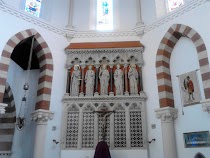
Two years after the church opened, in 1863, St Pancras faced some trouble. There were several protests against Catholics. During Guy Fawkes night, the priest had to hide in his house for two days.
The mayor of Ipswich had to get 200 special police officers to stop the protests. However, these events actually made many local leaders feel more kindly towards the church and the Catholic community.
In 1871, St Pancras became its own separate parish. For the first ten years, it was looked after by the Pallottines. This was a group of priests from Italy. In 1885, St Pancras joined with St Mary's to become one parish. St Pancras was chosen as the main church because it was more central.
In 1919, St Mary's became its own parish again. St Pancras used to serve the areas of Old Stoke and the Chantry Estate. But later, this part of the parish became the parish of Saint Mark's.
In the 1940s, St Pancras became a center for the Polish community in Ipswich. Later, the St Mary's parish became the main place for the Polish community.
In 1976, St Pancras and all other Catholic parishes in Suffolk joined the new Diocese of East Anglia. On Christmas Day in 1985, the church was badly damaged by a fire. This meant the choir area and the organ had to be rebuilt.
Church Design and Features
St Pancras is a special building. It is a grade II listed building. This means it is important and protected. It is built from red brick and has a slate roof.
The main altar is at the east end of the church. Behind the altar are decorative screens called reredos. Above these screens are five large statues. They show Jesus Christ with the Four Evangelists.
To the north of the main altar is a small Lady chapel. It has a beautiful marble altar with flowers carved into it. On this altar is a statue of the Blessed Virgin Mary. The tabernacle is right behind the main altar. A Victorian lamp hangs from the ceiling between the main altar and the Lady Chapel.
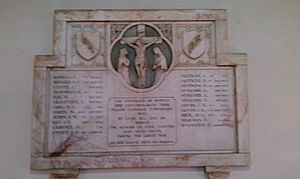
The choir loft is at the west end of the church. It was mostly rebuilt in the 1980s after the 1985 fire. The church organ is in the choir loft. This organ was built in 1891 and has two keyboards.
At the back of the choir loft, there is a large, modern stained glass window. It is a rose window and shows the Holy Spirit coming down. An Ipswich artist named Danielle Hopkinson made it for the Millennium.
Below the choir loft, behind iron gates, is a Caen stone baptismal font. There are also two war memorials here. One is a marble plaque from 1922. It remembers the Catholics of Ipswich who died in the First World War. The other is a painted copy of the icon of Our Lady of Czestochowa. This was given by the crew of a Polish armored train who were in Ipswich during the Second World War.
The main part of the church, called the nave, and the area around the altar, called the sanctuary, are in the Venetian style. This means the arches are made of alternating red and white bricks. The inside of the church used to be many colors. Now, it is mostly white. The church has a detailed wooden roof. The wooden pews are the original ones.
To the west of the church is the priest's house, called the presbytery. It has a small garden. In the garden, there is a copy of the statue of Our Lady of Ipswich. There is also a church hall built in the 1970s. The original priest's house was built in the 1700s. It was taken down when the Ipswich Council widened a road.


